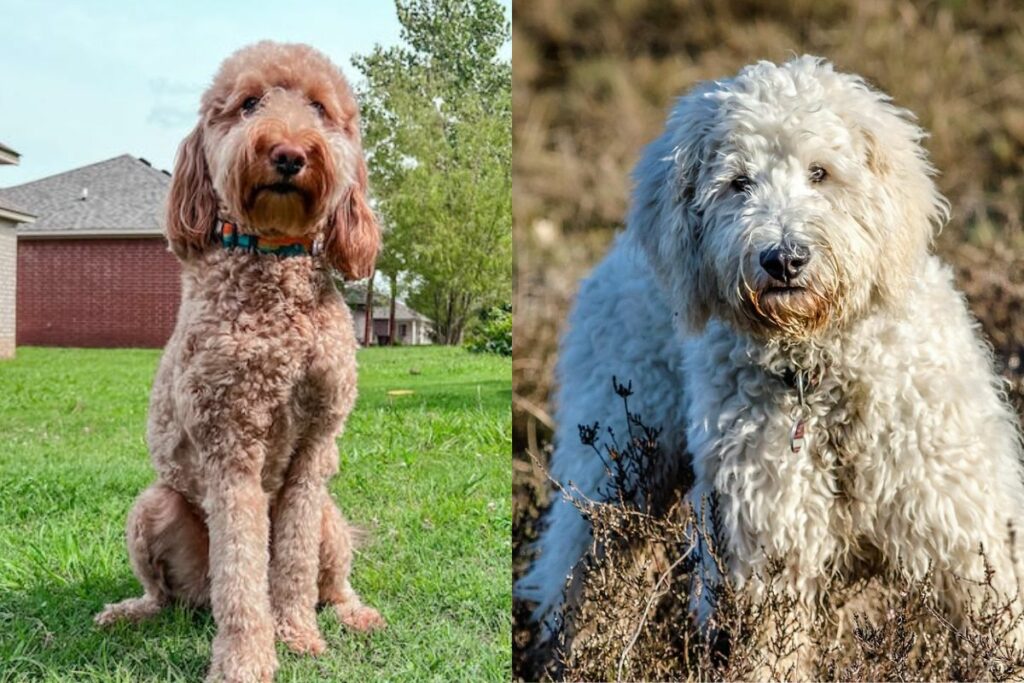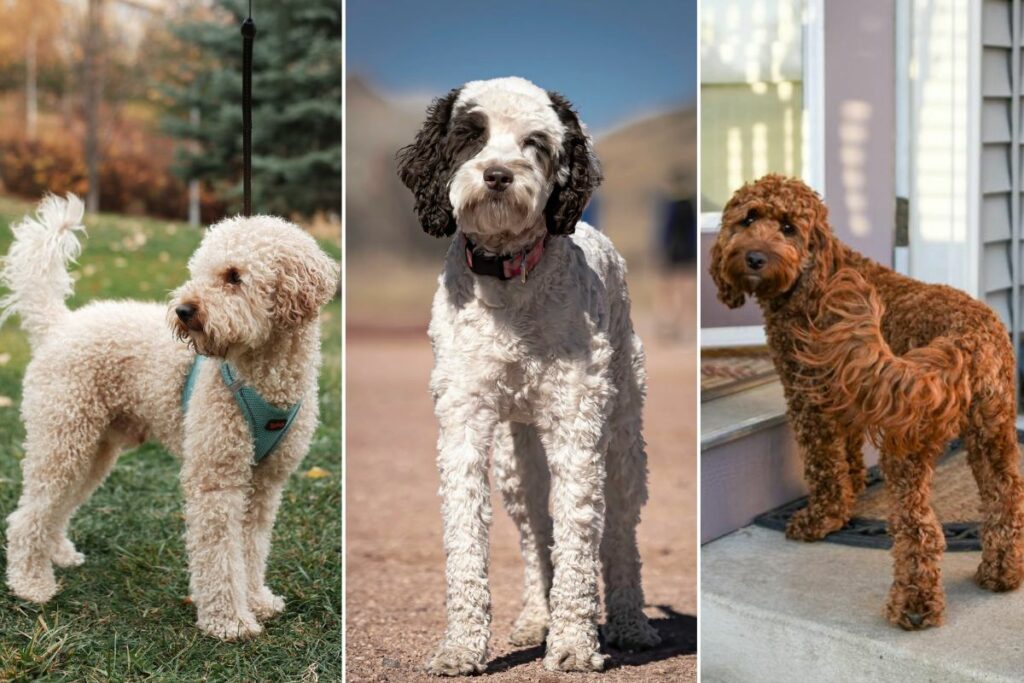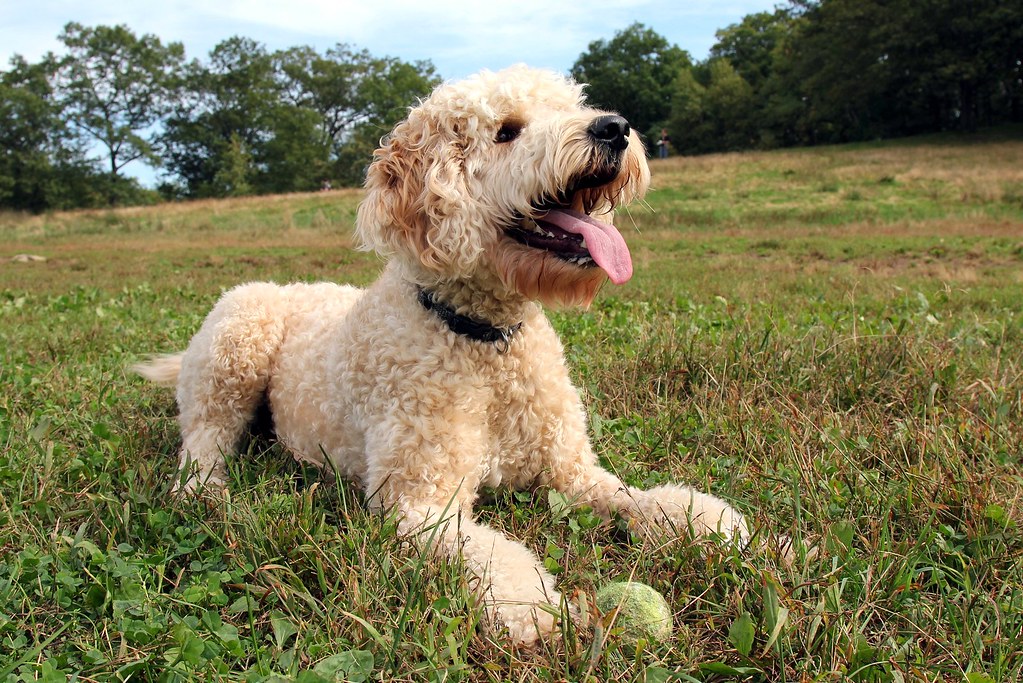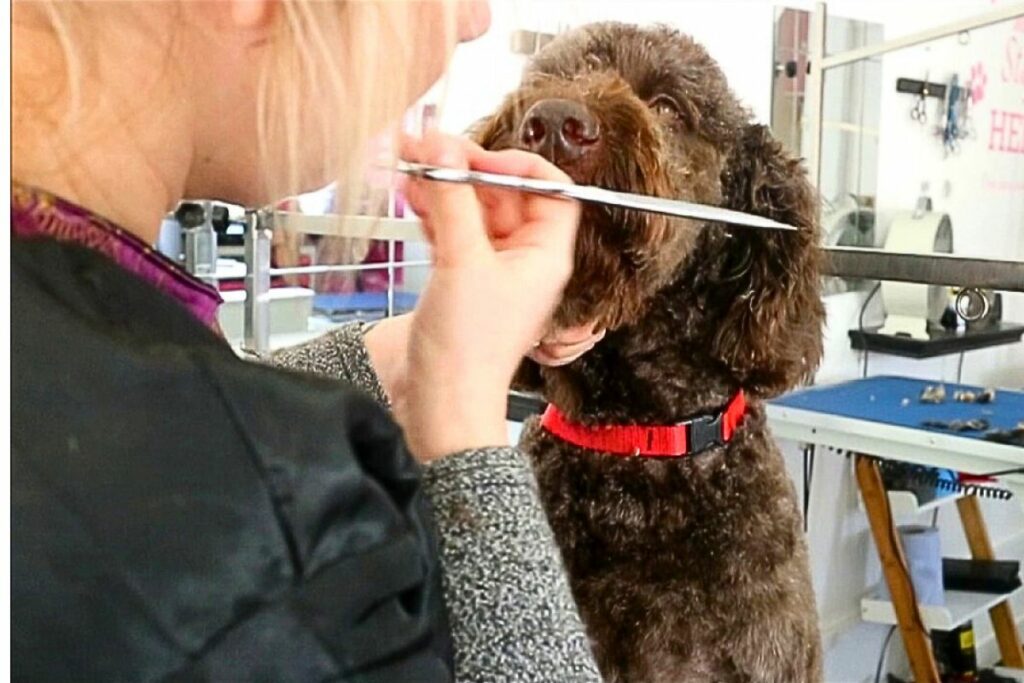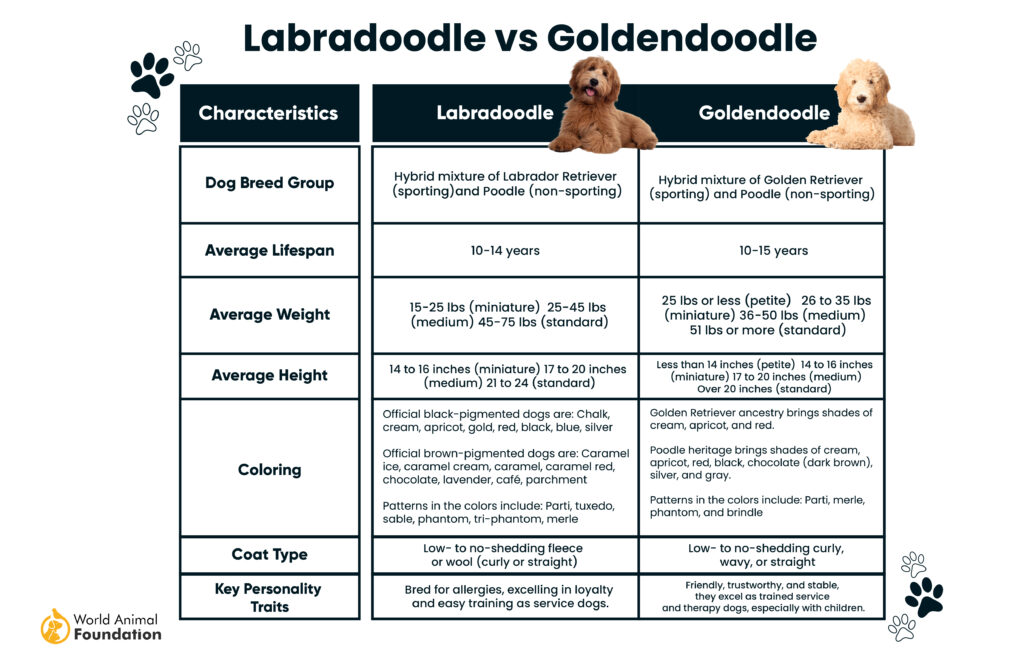Labradoodles and Goldendoodles: the fluffy, allergy-friendly contenders vying for the title of “perfect family dog.” But beneath the cuddly exterior lies a world of subtle differences. This playful versus placid, energetic versus even-tempered debate rages on, leaving potential owners bewildered. Unraveling the doodle dilemma means diving deep into temperament, grooming, exercise needs, and health predispositions. Join us as we explore the nuances of each breed, helping you choose the doodle destined to become your best furry friend.
“Doodle” mixes have become so popular in the last few years, and for good reason. Labrador Retrievers, Golden Retrievers, and Poodles are all excellent family pets with amazing characteristics, so it makes sense that when either of the retrievers are parent breeds with the Poodle, you’ll end up with a fantastic crossbreed dog.
Not to mention the cuteness (swoooon)! Goldendoodles and Labradoodles literally look like walking, barking teddy bears.
However, while Goldendoodles and Labradoodles do share a lot of similarities — I sometimes cannot tell one from the other, they’re that close — they are different in notable ways. These differences define the dogs and can help you distinguish which one would be the better option for you.
Labradoodle vs Goldendoodle: Spotting the Difference
Though the two mixed breed dogs may look the same, they actually have several slight differences, other than one being a Labrador Retriever mix and the other a Golden Retriever mix. Let’s dive into each one of these differences just a little bit more.
History
The Labradoodle actually isn’t an American creation. The Labrador Retriever and Poodle were first bred by Wally Conron in Australia in 1988. The reason behind the crossbreeding is amazing, too.
Conron wanted the Australian Labradoodle to be a solution for a blind woman who needed a seeing-eye dog but whose husband had dog allergies.
He was meticulous in his endeavor, too. He didn’t just breed a Labrador Retriever with a Poodle and call it a day. He had the couple test several different types of dog hair to see which he reacted to. Thus, the Australian Labradoodle was born.
Fun fact: the Australian Labradoodle also usually contains a bit of Cocker Spaniel.
The Goldendoodle hybrid was created around the same time period, too, and it also hails from Australia. Unlike the beautiful story that surrounds the Labradoodle, it’s not clear exactly who decided to create the Goldendoodle first or the exact date it first appeared.
Average Life Span
The average lifespan of a Labradoodle is between 10 and 14 years. Similarly, the Goldendoodle lives about the same amount of time, between 10 to 15 years. This lengthy life expectancy is due to their overall health, but I feel it should be said that these are just estimates.
Some will live much shorter lives, especially if they have health issues due to poor breeding, and some will live longer than 15 years, giving you even more time with your best bud.
Height and Weight
When it comes to size, you’d probably be surprised to know that the Labradoodle puppy comes in three varieties: miniature, medium, and standard. The mini Labradoodle stands 14″ to 16″ tall, the medium stands 17″ to 20″ tall, and the Standard is between 21″ and 24″. These are due to mixing the pups with the various poodle sizes, including the Toy Poodle.
The Labradoodles’ weight varies, as well. The miniature clocks in at 15 to 25 pounds, while the medium Labradoodle weighs 25 to 45, and the standard is between 45 and 75 pounds.
If you thought three was a lot, wait ’til you hear about the Goldendoodle! This dog comes in four different sizes: petite, mini, medium, and standard. These dogs tend to match up with the size of the Labradoodles as follows:
- Petite – Under 14″ and 25 pounds or less
- Mini – 14″ to 16″ and 26 to 35 pounds
- Medium – 17″ to 20″ and 36 to 50 pounds
- Standard – Over 20″ and 51 pounds or more
Coat Type and Color
One of the easiest ways you can tell a Labradoodle vs Goldendoodle apart is by their coat types. Labradoodles tend to have tighter curls than Goldendoodles, which is due to the thicker hair follicles Labradors have.
However, there are hair-coated, fleece-coated, and wool-coated Labradoodle puppy varieties. The hair-coated varieties aren’t as common as the other two, and their fur resembles that of the Lab. Those with fleece coats are more popular and are low-shed coats. The lowest shedding of all three is the wool-coated, which is the best hypoallergenic solution.
Labradoodles typically come in white, chocolate, cream, red, or yellow. But when you throw in the Poodle’s coat colors, you could even end up with a brindle, merle, or parti coat.
In contrast, the Goldendoodle coat has a fluffier look about it with loose, wavy fur. If you find a Goldendoodle with thick, straight fur, be warned that they tend to shed more and likely won’t offer a good hypoallergenic solution.
Golden Retrievers are typically in the light to dark gold color scheme and may have caramel, red, gold, or cream-colored pups. Throw in purebred Poodles, and you might get a coat color in black or chocolate, plus the fun color patterns of merle, brindle, and parti, like the Labradoodles.
Temperament
When it comes to picking a dog, temperament is everything. In this case, both Goldendoodles and Labradoodles are amazing all around.
The Labradoodle is a loyal pup with a friendly disposition and playful nature. They love other dogs and tend to do well with other animals if you socialize them properly. One thing you definitely don’t want to do is ignore your Labradoodle unless you want it to become destructive.
It simply wants to be around its people, so shower this baby with affection! If you’re looking for a protector, be warned that Labradoodles typically aren’t great guard dogs. They love everyone and just want to be friends.
Like the Labradoodle, the Goldendoodle is loving and warm. They are highly intelligent and easy to train, which makes them great family dogs. Many also use the breed to serve as a guide dog or therapy dog because they’re simply wonderful with people.
This pup won’t be a great guard dog, either. It’s a good idea to train this pup early on to curb its enthusiasm because when I say it’s boundless… I mean, it’s boundless. It’s okay — and very highly recommended — to set boundaries.
Needs for Grooming
When it comes to Labradoodle grooming, you can expect to spend a lot of time on its coat. Labradoodles are unique in that their full coat doesn’t come until they are around a year old. They also tend to have hypoallergenic coats, but that isn’t true of all of them, so it’s important to test to avoid agitating allergy sufferers.
Frequent brushing is necessary with these Poodle mixes, as is a full grooming every four to eight weeks, depending on how fast its fur grows. Daily brushing is highly recommended, and your dog will benefit from a shiny coat because of it! Then, as part of your Labradoodle grooming, you’ll want to clip its toenails at least once a month, too, sometimes more if they grow fast.
Goldendoodles are also high maintenance when it comes to grooming. They need lots of brushing to prevent their fur from tangling, and like the Labradoodle, regular grooming keeps its coat shiny.
When it comes to poodles and the type of curly fur they have, many people have also sought to do unique looks, such as dreads, which is totally fine, but make sure if you go this route, you make shampooing a regular part of your grooming routine.
Care and Feeding
Labradoodles are very regulated when it comes to food; they often don’t overeat unless they have experienced issues that would cause them to be very greedy.
When it comes to feeding your Goldendoodle, because of its proneness to sensitive stomachs, it’s best to keep their food the same. Don’t keep switching it up. This would aggravate any pup’s stomach, let alone one that already has digestive issues.
Level of Activity
When it comes to the level of activity, the Labradoodle slightly edges the Goldendoodle out. This dog has high energy levels that need attention. If you have a fenced-in backyard, they can wear themselves out running or playing fetch — plus, they even love agility training! Otherwise, commit to long walks or hikes to get that energy out.
When it comes to the Labradoodle vs Goldendoodle, the latter is the calmer of the two. However, they still need their exercise! The good thing is, since they’re not high-energy dogs, you can get away with about 30 minutes of moderate exercise per day. Like the Labradoodle, the Goldendoodle loves to swim and romp around.
Health
One note of caution before I dive into the health of the Goldendoodle vs Labradoodle. It’s best to adopt from quality breeders, those who will do health testing and won’t just mate dogs and churn them out like puppy mills. Paying attention to genetics and health history is essential to breeding healthy dogs that will live long lives — and isn’t that what we all want?
Labradoodles are typically healthy breeds, especially if they come from high stock. However, there are a few things to be on the lookout for, such as hip dysplasia, which is common in the breed, and eye disease. Additionally, Labradors have floppy ears, which can contribute to ear infections, especially if they’re not cleaned regularly.
Goldendoodles have the same issue with hip dysplasia from time to time, but they are also prone to having sensitive stomachs, as noted above.
Training
When it comes to training the Labradoodle vs Goldendoodle, there are different approaches to take based on their temperaments and the way they love to learn. They are both really smart dogs, so they won’t have trouble picking up tasks, but the way you teach may need to be different.
Labradoodle training should always start with developing a positive relationship between dog owners and the pup. Be positive rather than reactive. Instead of yelling, redirect. One great trick to teach your dog is to stay or relax. This can help immensely with jumping and other negative behaviors.
The Goldendoodle gets very bored very quickly, which can be a hindrance to training, but you can solve this by changing up the tasks and introducing new enrichments.
Structure and consistency are the name of the game when it comes to training a Goldendoodle vs. Labradoodle because they can get frustrated if they are confused.
Popularity of Breed
When comparing the Goldendoodle vs. Labradoodle in terms of popularity, it’s hard to say which one of these dog breeds edges the other out because they are not recognized by the American Kennel Club.
Both Labradoodles and Goldendoodles have amazing temperaments and personalities and tend to be amazing family pets. Over the past few decades, the adoption rates of these pups have soared because they’re just that charming.
Comparison Chart for Labradoodle vs. Goldendoodle
Goldendoodle vs. Labradoodle: Cost Overview
One of the things that we have to keep in mind when adopting dogs, especially popular ones like the Labradoodle and Goldendoodle, is the cost. This includes not just the adoption fee — which can be higher, around $1500 to $3500 for those by top breeders — but also costs that go into the regular care and grooming for the pups.
Don’t be put off by the higher price tags if you are looking at a reputable breeder. That’s precisely why they are higher because they took the time and effort to ensure that only the top dogs in their packs are bred.
As far as grooming goes, you can expect to visit your groomer at least six times a year, and it can be costly depending on where you live and how you get your dog groomed. Then, there are regular vet visits and any health issues that may crop up over the span of your dog’s life.
FAQs
Which Is Better, a Labradoodle or a Goldendoodle?
Honestly, this is a very subjective question. It depends on several factors, including what you plan to use the dog for. For example, a Labradoodle would be a better hunting companion or a working dog, while a Goldendoodle is best suited to be a therapy dog because of its sunny disposition (seriously, they’re always smiling!).
Which Doodle Is the Best Family Dog?
All three breeds involved in these two crossbreeds are excellent family dogs. However, if I had to pick one, it would be the Goldendoodle because of its eagerness to please and happy-go-lucky attitude that does well with adults and kids alike.
What Is the Temperament of a Labradoodle?
If you adopt a Labradoodle, you’re in for a whole world of fun. Seriously. These pups are extremely outgoing and friendly and love to keep busy. They easily make friends and are amazing for first-time pet owners because they’re highly intelligent, which makes them easy to train.
Is a Goldendoodle or Labradoodle Better for Allergies?
When comparing the Goldendoodle vs Labradoodle, Labradoodles tend to be the better doodle dog in this respect. But make sure you do some allergy testing because the genetics of each dog is different. Testing is a great way to prevent having to rehome your new puppy because of allergic reactions and cause upset on all sides.
Final Thoughts
I love both the Labradoodle and the Goldendoodle, and honestly, no matter which one of these doodle dogs you choose to go with, you can’t go wrong. They’re both devoted companions who love their people and make friends with every Jim, Sally, and Fido they encounter.
Just be diligent in your research so you know what to look for in terms of a well-bred dog and identifying health concerns, and then be prepared to enjoy the next dozen or so years with them because it’s gonna be a wild ride — in the best way!
Ultimately, the “best” doodle boils down to individual preferences and lifestyles. Labradoodles often possess a more athletic, sometimes mischievous energy, while Goldendoodles are generally known for their gentle, people-pleasing nature. Both breeds require considerable grooming and benefit from early socialization and training. Researching breeders carefully is crucial for ensuring a healthy, well-adjusted puppy regardless of whether you choose the playful Labradoodle or the affectionate Goldendoodle. Consider your activity level, living situation, and desired temperament when making your decision – the perfect doodle is out there waiting!



